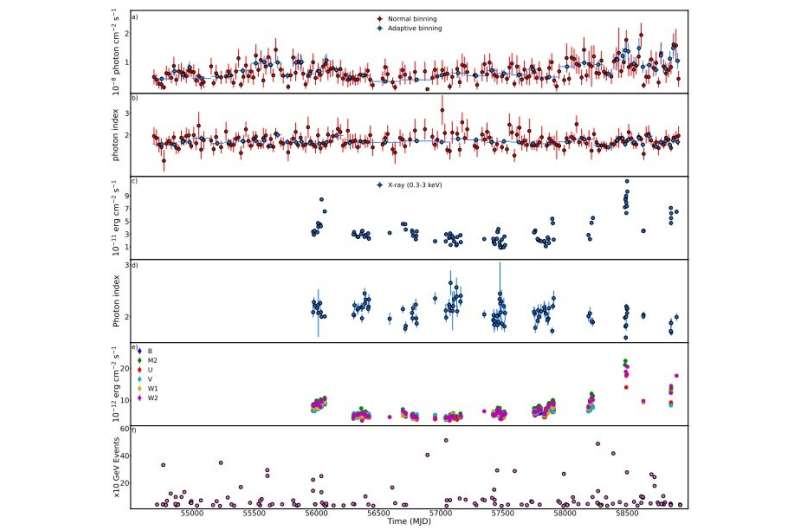July 7, 2020 report
Emission from the blazar 1ES 1218+304 explored with NASA space telescopes

Using three NASA space observatories, astronomers have conducted a multiwavelength study of emission from a blazar known as 1ES 1218+304. Results of the investigation, presented in a paper published June 29 on arXiv.org, deliver more insights into the properties of this high-energy source.
Blazars are very compact quasars associated with supermassive black holes at the centers of active, giant elliptical galaxies. Based on their optical emission properties, astronomers divide blazars into two classes: flat-spectrum radio quasars (FSRQs) that feature broad, prominent optical emission lines, and BL Lacertae objects (BL Lacs), which do not.
Some FSRQs are high synchrotron peaked (HSP) sources as their synchrotron peak is above 1,000 THz in the rest frame. Observations show that particles are efficiently accelerated up to very high energies (VHEs) in the jets of HSPs, which makes such sources very interesting for astronomers studying extreme blazars.
At a redshift of approximately 0.182, 1ES 1218+304 is a HSP blazar detected in 2003 and first observed in VHEs in 2006 with the Major Atmospheric Gamma-ray Imaging Cherenkov Telescope (MAGIC). It exhibits hard gamma-ray spectrum from MeV/GeV to TeV band, suggesting that the emission is most likely produced from fresh accelerated electrons. This makes it an ideal target to investigate acceleration and cooling processes for the emitting particles.
A team of astronomers led by Narek Sahakyan of the International Center for Relativistic Astrophysics Network (ICRANet) has analyzed the data from NASA's Swift, NuSTAR and Fermi spacecraft in order to unveil the origin of the multiwavelength emission from 1ES 1218+304. They have conducted a detailed temporal and spectral analysis of the data collected between 2008 and 2020 in the gamma-ray, X-ray and optical/ultraviolet bands.
"The purpose of this paper is to investigate the origin of broadband emission from 1ES 1218+304 by analyzing the most recent available data," the astronomers wrote in the paper.
The observations show that the long time-averaged gamma-ray spectrum of 1ES 1218+304 is hard with a photon index of 1.71 and with a flux of about 0.0000000189 photon/cm2/s. The gamma-ray emission was found to extend up to about 600 GeV.
Analysis of the data unveiled a flux increase in the ultraviolet/optical and X-ray bands. The highest 0.3-3 keV X-ray flux was at a level of approximately 0.000000000.113 erg/cm2/s. In the 0.3-10 keV range the averaged X-ray photon index was found to be above 2.0, softening to about 2.56 in the 3-50 keV band.
However, Swift data reveal an interesting modification of the X-ray photon index in some observations. It is mostly above 2.0, as expected for HSP sources, but there are periods when the photon index hardens to below 1.80. This suggests that the peak of the synchrotron component was above 1.0 keV, and that 1ES 1218+304 behaved like an extreme synchrotron BL Lac object.
Moreover, the magnetic field in the jet emitting region of 1ES 1218+304 was measured at approximately 0.015 G. This is in agreement with the spectral energy distribution (SED) modeling of other known HSPs.
In concluding remarks, the astronomers noted that based on collected data, it is still too early to confirm if 1ES 1218+304 is a normal HSP or an extreme blazar. Further large multifrequency observations of this source could verify these scenarios.
More information: Broadband Study of High-Synchrotron-Peaked BL Lac Object 1ES 1218+304, arXiv:2006.16030 [astro-ph.HE] arxiv.org/abs/2006.16030
© 2020 Science X Network





















